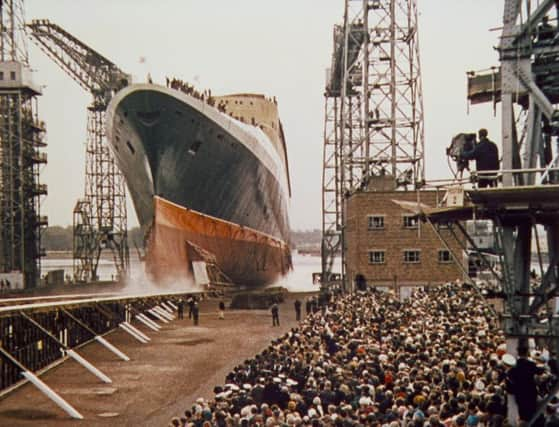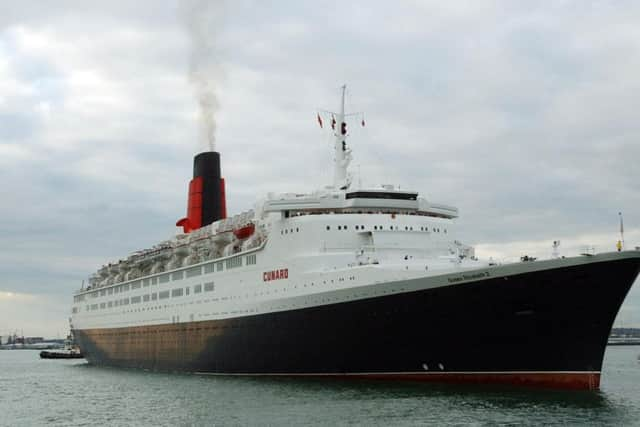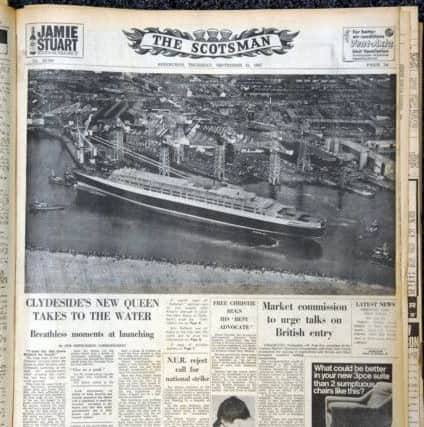Campaign to bring QE2 back to Clyde


Calls are growing to save one of the world’s most celebrated ocean liners from a perilous future and return her permanently to the banks of the Clyde.
Years after being taken out of service, the QE2 – for many the epitome of seafaring elegance – remains laid up in a Dubai dock. Plans to grant the ship a new lease of life as a luxury hotel have long since stalled and there is little indication as to when, or if, they will resume.
Advertisement
Hide AdAmid fears the historic ship is falling into a state of disrepair, politicians and community activists in Inverclyde have issued a rallying call for authorities across Scotland and the UK to help make her homecoming a reality.


In what has been described as a project of “herculean” ambition, civic figures in the region say having the QE2 back home would be a “tremendous” economic boost, while also safeguarding an integral part of Scotland’s rich maritime heritage.
Tomorrow will mark 50 years to the day since the QE2’s keel was laid down by John Brown & Company, the Clydebank shipyard responsible for some of the world’s most illustrious ships.
She was launched by the Queen in 1967 and fitted out in Greenock. It was to be the start of four decades of proud service which took in the Falklands War and innumerable world tours, spanning millions of miles and as many cocktails.
After her final journey in 2008, the Cunard liner was sold to Dubai World, a UAE conglomerate who intended to overhaul her interiors, creating an opulent getaway. But talk of refitting the QE2 in China has, to date, proved just that.


For those in Inverclyde and further afield, the images of the Clyde-built ship stuck in limbo in Dubai’s Port Rashid have strengthened their resolve to reclaim her.
Advertisement
Hide AdRob Lightbody, a member of online campaign group The QE2 Story, warned the liner’s condition has been deteriorating since the engines were turned off in 2013. “It’s just sitting in Dubai,” he said. “Nothing has happened to it in the last two and a half years. There’s no power. There’s no air. She’s filthy.”
Stuart McMillan, SNP MSP for the west of Scotland, said: “The QE2 coming to Inverclyde would be a tremendous tourism and economic boost to the local area. If this project was to succeed, it would generate more jobs for the area and restore a key part of Scotland’s maritime heritage to Inverclyde.”
Advertisement
Hide AdMr McMillan admitted such an initiative would require an entire fleet of agencies working together, adding: “This would include representation from the Scottish Government, Scottish Enterprise, Inverclyde Council and Clydeport. I would be more than happy to encourage all parties to get involved.”
Stephen McCabe, leader of Inverclyde Council, admitted the Scottish and UK Governments would have to work closely if there was to be any hope of securing the ship. He said: “Bringing the QE2 home is a herculean task, one that requires national support in Scotland and perhaps across the UK, if it has any chance of happening.
“Given the reception just a few weeks ago to the Queen Mary 2 on the 175th anniversary of Cunard on the Clyde, it is clear that the QE2 could be a major draw for visitors to Inverclyde and Scotland. It could also boost the promotion of the Clyde and Inverclyde’s proud maritime history to a national and, potentially, international audience.”
However, Chris McEleny, leader of the council’s SNP group, questioned how practical such a project may prove to be.
“It could be that the scale of finance required is too much,” he said. “Therefore we need a feasibility study put together very quickly to highlight if the cost would be worth it.”